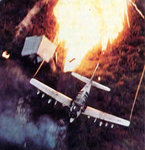A
Anonymous
Guest
mosquitoman said:Thanks for that Lanc, it was the same colour scheme
The Mossie could carry the same amount as a B-17 and that had 2 engines of similar size to the B-17's
The engines on the Mossie were larger than those of the B-17 and had about 30% more power.
The Mossie carrying 4,000 lbs of bombs could not carry them as far as the B-17 carrying the same bombload. For the same range, one plane vs. one plane, the B-17 could carry 8,000 lbs of bombs as far as the Mossie could carry 4,000 lbs of bombs. However, in practice, forming up time ate a lot of fuel and reduced the typical B-17 bombloads to 4-6,000 lbs.
=S=
Lunatic

